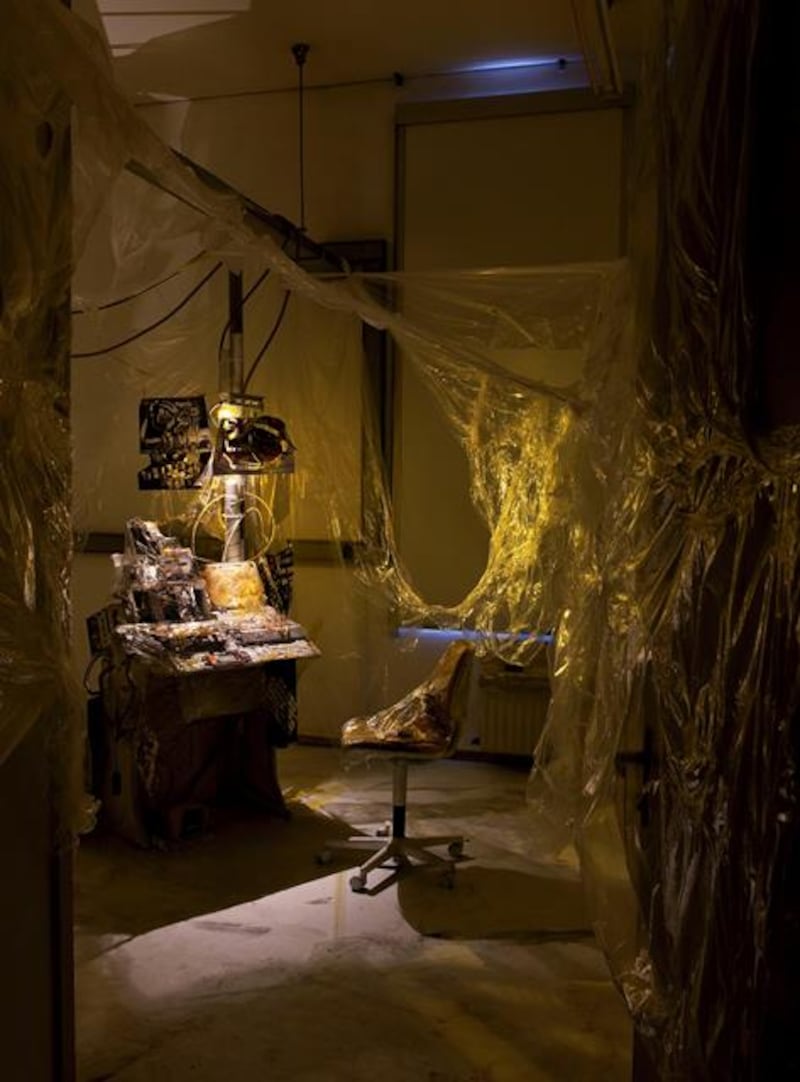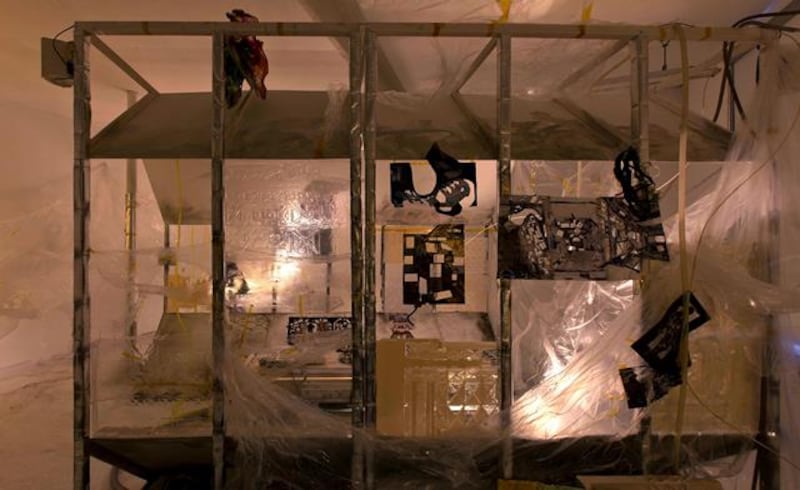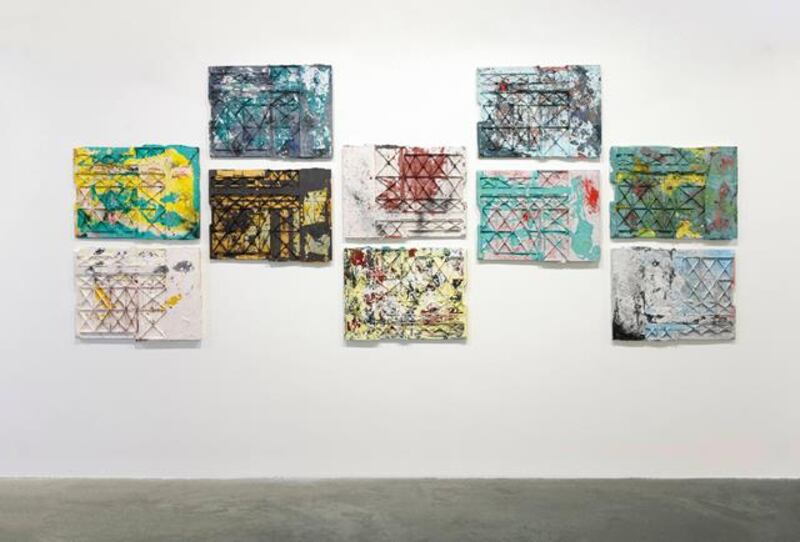Sam Keogh: Kapton Cadaverine
★ ★ ★ ★
Kerlin Gallery, Anne's Lane, Dublin 2
To say Sam Keogh is drawn to characters in crisis is to put it mildly. Three of his solo shows in Dublin have centred on troubled, distracted, frantic protagonists, mostly embodied by the artist in performances that blend seamlessly into sculptural installations. Embodied is a particularly apposite term for Kapton Cadaverine, which features a kind of chaotic stage installation roughly divided by walls of plastic sheeting.
Within the divisions is a bed similar to a hospital trolley or operating table, an array of computer keyboards, and a light-box table full of what might be organic cultures in improvised Petri dishes. The ubiquitous plastic is torn and sagging, discarded tubing and bags are strewn all around, and every surface is wreathed with pools and clots of what could be bodily fluids; viscous, messy and dirty. Collaged imagery suggests android-like creatures, hybrids of synthetic and organic elements. A host of dismantled wall panels are discoloured by “adulterants, which blossom just under their surfaces.”
Keogh previously disrupted the Kerlin's white cube space in 2013, depositing precarious islands of fragmentary images and detritus on the floor. Visitors found themselves in the domain of Oscar the Grouch, the resolutely negative misanthrope from Sesame Street who lives in a dustbin and hoards rubbish. Keogh accumulated materials that seemed to him "Oscarish" – broken things, rotten fruit, and also images of Samuel Beckett and Elvis Presley in bloated decline – and distributed them throughout the gallery.
A couple of years later he imprinted a vast photographic enlargement of a disinterred bog body, Old Croghan Man, recovered from the peat in Co Offaly, on the floor of the Douglas Hyde Gallery. His opening performance saw him running around, lifting huge flaps of the body's leathery skin to reveal not an anatomically accurate interior, but a plethora of material relating to our treatment of human remains – his starting point had been his mother's unease about an interactive "virtual autopsy" of a similarly preserved figure in the British Museum.


Mineral ‘mountain’
Prior to these, when he wasn't long out of college, Keogh created a huge mineral "mountain" at the Project Arts Centre, Terrestris, surrounded by chunks of minerals mined from its core. Besides its innate physical qualities, the work was also metaphorically rich (he alluded to returning the abstraction of minimalism to the reality of the earth). It left Keogh a little dissatisfied and he has, arguably, challenged himself more ever since, with Oscar, hapless Croghan Man and now the astronaut in Kapton Cadaverine.
Keogh, in the performance that “activates” his current installation (headphones with an audio recording are available) is an astronaut who’s been prematurely woken from cryogenic suspension when his spacecraft is damaged en route to a distant planet; a planet being prepared for human habitation. His predicament is disastrous. Travelling close enough to the speed of light to mean the world he’s left behind is several centuries older, he cannot return home, but on his damaged ship he can’t resume his cryogenic state. The mess around him bespeaks his desperate efforts to patch things up. Profoundly alone, he asks to be left alone, treating his audience as nothing more than an echo of the earth he has lost forever.
The show’s title sounds almost like a character’s name and rank; rank is perhaps an all too appropriate term. “Kapton” is an exceptionally stable but short-lived polymer film, used in cryogenics and spacecraft, among other things. It can fail, as it has here. “Cadaverine”, as the word disturbingly suggests, is a toxic, stinking compound produced by putrefying animal tissue.
On another level, there are indications the astronaut inhabits a fictional space, that Keogh is not exactly trying to anticipate a potential future predicament and tease out the implications. The fictional nature of the space is indicated by the clear artifice of the set and the props. Rather than being futuristic, there is a retro feeling to the setting. It could be that the “astronaut” is here and now, but psychologically inhabiting an imagined extraterritorial future.

Cinematic sci-fi
Keogh's installation lies firmly within the grunge tendency of cinematic sci-fi, which runs counter to the conscious grandeur of 2001: A Space Odyssey, say, or the swashbuckling of Stars Wars. By contrast, in the 1972 film Solaris, Andrei Tarkovsky's protagonist Kelvin travels to a run-down, dilapidated space station where the occupants have retreated into haunted, inner emotional worlds, as indeed he does. Ridley Scott set the tone with the visceral eruption of the title creature in Alien, a film in which space travel is about as glamorous as long haul freight transport. A few years later the promise of AI and other future technologies end in tears in Scott's Blade Runner.
By accident or design, Kapton Cadaverine nods to Alien, in which the crew are jolted out of their cryogenic rest, and Solaris, where Kelvin finds himself confronted by his long-dead partner (Keogh's astronaut summons a voice from his past via his Alexa-like computer assistant). Keogh's consciously skewed use of performance, installation and sculpture in uneasy concert is exceptional.
- This work came about with support from the Rijksakademie Amsterdam (during his residency there) and EVA International 2018, in which it will be included. Until March 10th, kerlin.ie











